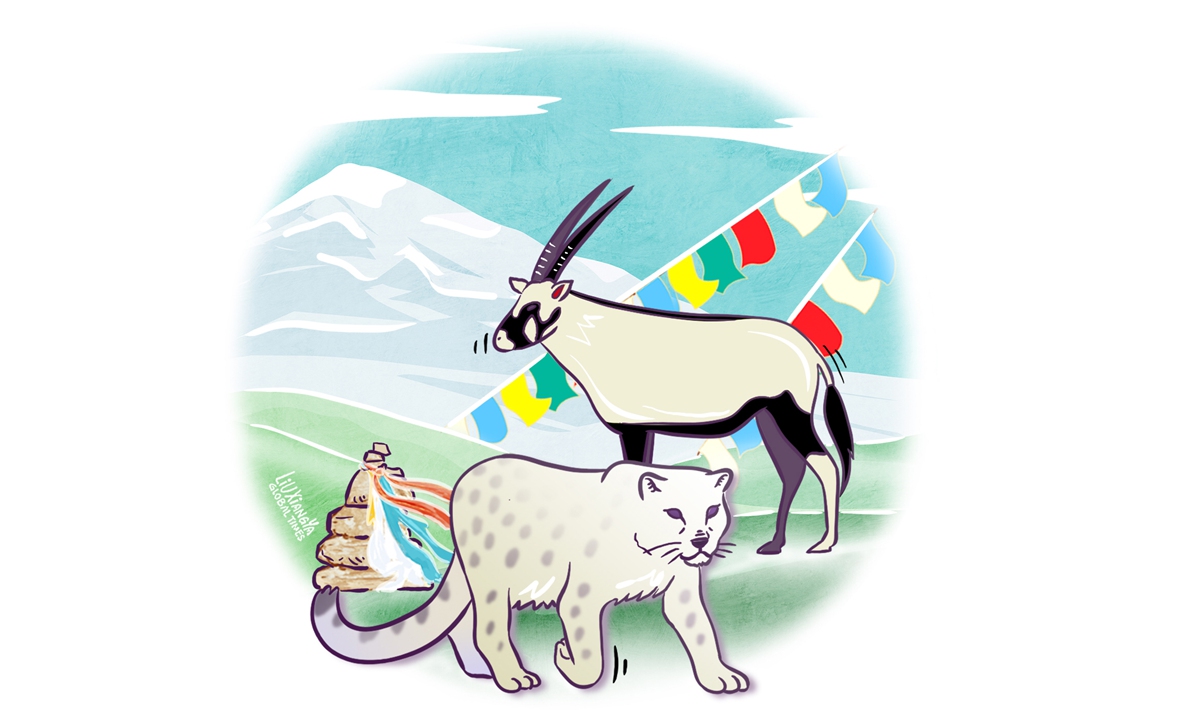ARTS / CULTURE & LEISURE
Profound connection between Tibetans and animals

Illustration: Liu Xiangya/Global Times
On a high plateau in the mountains, there was a majestic white antelope, considered the spirit of the mountains and revered as a sacred being. This white antelope freely roamed between the grasslands and high peaks. One day, a woman named Yang Xiu discovered this white antelope by the lakeside of the plateau. She was captivated by the beauty and nobility of the antelope, feeling a mysterious closeness. Yang Xiu established a special connection with the white antelope, as if it could understand the depths of her heart.
During a snowstorm, Yang Xiu got lost deep in the mountains. Feeling helpless, the white antelope appeared by her side, guiding her back home. Yang Xiu realized that it was not just an antelope; it was also the guardian spirit of the mountains. Upon returning home, Yang Xiu shared her experience with the villagers. Consequently, the white antelope became a symbol of divine presence and the guardian spirit of the mountains. People revered the white antelope as a sacred representative in rituals and ceremonies, expressing respect for life.
When humans face harsh environmental conditions, companionship becomes increasingly crucial. The story above reflects the profound connection between the Tibetan people and animals thriving for thousands of years on the snowy plateau, emphasizing their reverence for nature and respect for animals.
Such stories are passed down in Tibetan culture, becoming a part of shaping their values and beliefs. The relationship between Tibetan people and other living beings is reflected in their daily lives and religious beliefs.
In pastoral life, animals play vital roles. Those who have been to China's Xizang region know that extreme weather conditions are common in this region. Pastoralism is a crucial pillar for sustaining people's livelihoods. Animals like yaks, sheep, and horses are essential for local people. They provide not only food, fur, and bones but also solace in a desolate landscape. The intimate collaboration between people in Xizang and these animals forms a mutual dependency.
In traditional Tibetan medicine, some animal parts (such as bones, horns, fur) are used as medicinal ingredients, believed to have healing and health-promoting properties.
The significance of animals in Xizang is also reflected in religious practices. In Tibetan Buddhism, some deities are believed to incarnate as animals, leading to a profound respect for them. In the murals of Tibetan temples, one can always find images of animals like elephants, monkeys, deer, and rabbits - collectively known as the "Four Harmonious Friends" - symbolizing luck and fortune. These animals are considered auspicious, and encountering them is deemed highly fortunate.
Animals are also portrayed in a more metaphysical manner in Tibetan life. Throughout generations, Tibetan communities have practiced totem worship, considering certain animals as their ancestors or protective deities. The reverence for these animals is evident in daily life and ceremonies.
Wild animals in the highland region such as snow leopards and Tibetan foxes are seen as sacred beings with mystical powers. Some legends describe these animals as having a special connection with divine entities or serving as prophets capable of sensing natural disasters.
Another story from Xizang involves an elder named Ani. He had recurring dreams of a snow leopard guiding him to a mysterious valley. Choosing to follow the guidance of his dreams, Ani led a group of warriors on an adventurous journey. After traversing steep mountains and cold plateaus, they arrived at a valley shrouded in mist. In this valley, Ani discovered a sacred temple where the dream's snow leopard awaited them. From that moment, the snow leopard became their guardian deity, symbolizing strength, wisdom, and protection. The image of the snow leopard was carved onto the temple walls and became a totem worshiped by the locals. Considering the snow leopard their guardian deity, Ani and his tribe established an altar in the temple. Regular ceremonies were held to express reverence and gratitude toward the snow leopard.
Whether it's the white antelope or the snow leopard, these legends and tales not only reflect the survival relationship between the Tibetan people and animals but also play a significant role in cultural inheritance, shaping the perception of animals in the hearts of the people. These stories are more than mere entertainment; they carry deep respect for nature and life.
The reverence and respect persist from ancient mythological eras to the digital age. From early enlightenment, Tibetan children are taught by their parents and elders that every life deserves dignity. This innate humanism and compassionate spirit ensure that any act of animal cruelty is condemned and shunned. In urban life in Xizang, lost animals receive kindness and blessings from everyone.
The author is a lecturer at Hunan University, and holds a PhD from Renmin University of China. life@globaltimes.com.cn

